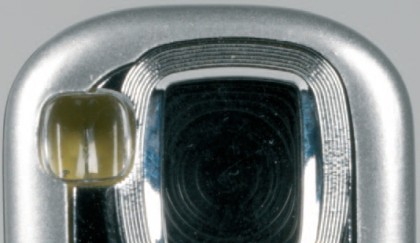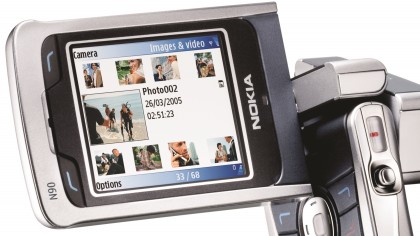Retro Phone Review: Nokia N90
As well as the MMC card there's 31MB of shared onboard memory, but the device's sheer usability means that it won't take long to fill this up – it almost sits up and begs to take snaps and make mini movies.
In use, the camera is easy and intuitive to use. Saving and searching for pics and vids is quick and easy too. There's a feast of onboard editing options, including cropping, framing, red-eye reduction, the rather bizarre 'cartoonise' and the ability to add elements of clip art.
There are more options still on the included data CD, which features Adobe Photoshop Album Starter Edition 2.0 as well as Adobe Mobile Video Editor for cutting, splicing and editing your videos.

In camera mode there are options for adjusting the white balance: automatic, sunny, cloudy, incandescent, fluorescent, exposure value: +/-2, six possible capture scene settings including Scenery, Portrait, Night and Sports as well as colour tone: sepia, black and white or negative.
There's an optional flash (a real one this, not just a permanently on or off photo light, though it can be used as that too). There's a 20x digital zoom too, which is handy for getting in close, though the picture quality is unreliable at full magnification, prone to fuzziness with loss of a lot of detail.
However, there is more to the N90 than a fancy camera. Based around the Symbian Series 60 smartphone operating system, there's plenty of scope to tailor what's onboard to your tastes with downloadable software applications and other add-ons.
Out of the box though it comes with a rich set of features, including RealPlayer for both making and viewing videos, as well as Nokia's own dedicated music player. Transferring MP3 and AAC tracks was easy using Nokia Audio Manager.
Sign up for breaking news, reviews, opinion, top tech deals, and more.
The stereo in-ear headphones supplied do a decent if not spectacular job of the audio, and include the standard Nokia FM aerial for use with the built-in radio. There's also a Nokia XpressPrint Printing Solution built in, which in theory allows you to connect directly to a printer via Bluetooth and print snaps directly without the need for a PC.
It has all the personal organisation features you could want, including calendar and reminders, voice notes, email and instant messaging clients, as well as Nokia's Lifeblog service, which allows you to upload pics and comments directly to your own website, so you can keep an account of, well, anything you want really.
Another photo-friendly feature that's included is Kodak Mobile Service, which offers unlimited online picture storage as well as allowing you to order prints directly from your phone.
There's a full Opera web browser as well as WAP internet access, voice recorder, spreadsheet and even a PDF reader on board – a very neat little software package, in other words. Given all this software action, it seems a bit stingy that there are only two basic games included in the package: the latest (admittedly addictive) Snake and Card Deck, though of course there's plenty of room for downloads.
Performance
This is very much a high grade cameraphone, with the emphasis on features and usability. Everything else, including convenience, discretion and pocketability (and price premium) has been sacrificed to this end.
The Carl Zeiss lens certainly seems to do the trick in the picture quality stakes. Still pictures are considerably better than those you'll get from other 2-megapixel cameras such as Sony Ericsson's K750i or even Sharp's still impressive 902.

There's additional depth, greater clarity, smoother picture rendering with less fuzziness around the edges and generally sharper imaging than anything we've so far seen from a cameraphone. Both in close-up and even longer range shots, in a variety of lighting conditions, these pics outshone any other cameraphone so far.
Video can get a little quirky, especially when there's fast movement involved, but again, in comparison with other cameraphones on the market, it rocks. In fact, once you've tried it, you may find it difficult to go back to a lesser camera, even for snaps. Colours look much more realistic, there is less tendency to glare and textures are richer – much more like a real digital camera, in fact.
General usability is very good, thanks partly to Symbian's Series 60 smartphone interface and also to Nokia's usual attention to detail in this respect. It's very easy to use as a camera, as a media device and blimey, even as a phone.
If only they could make it just a nudge smaller, this would be the soaraway success it deserves to be.
Verdict
The Nokia N90 was one of a range of devices that proved that phones could have impressive cameras without compromising in other areas.
Although the 2 megapixel camera isn't much to write home about these days, back when the N90 launched this was a seriously impressive specification.
The N90 was also the first phone to include a Carl Zeiss lens, which is something that many smartphones today proudly boast, and pushed it way ahead of the competition in terms of picture quality.
The N90 was Nokia's first entry in its high end N series of smartphones, and while its chunky design was a bit of a let-down (the latter N91 was a much more compact yet powerful device), it was enough of a hit to make us sit up and pay attention to see what the Finnish company had in store for us next, and scored 89% in issue 136 of Total Mobile.